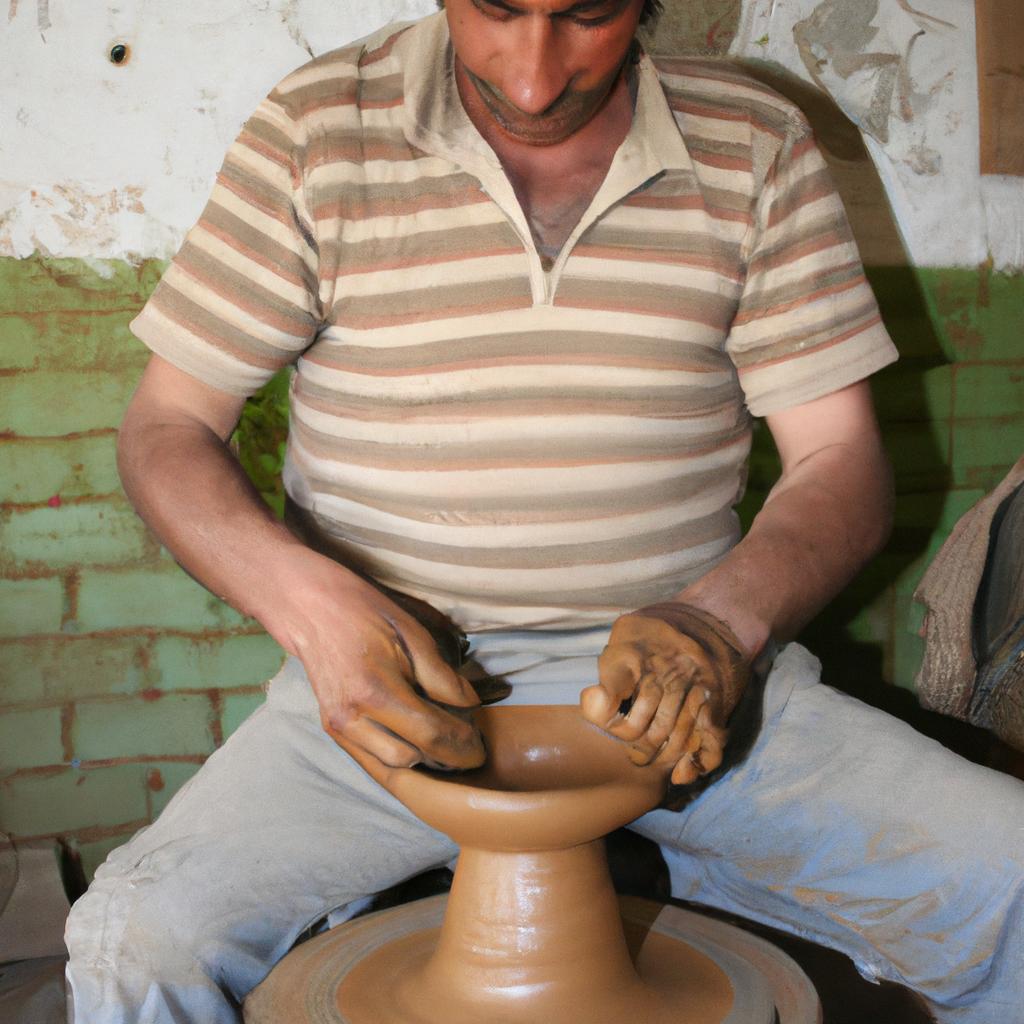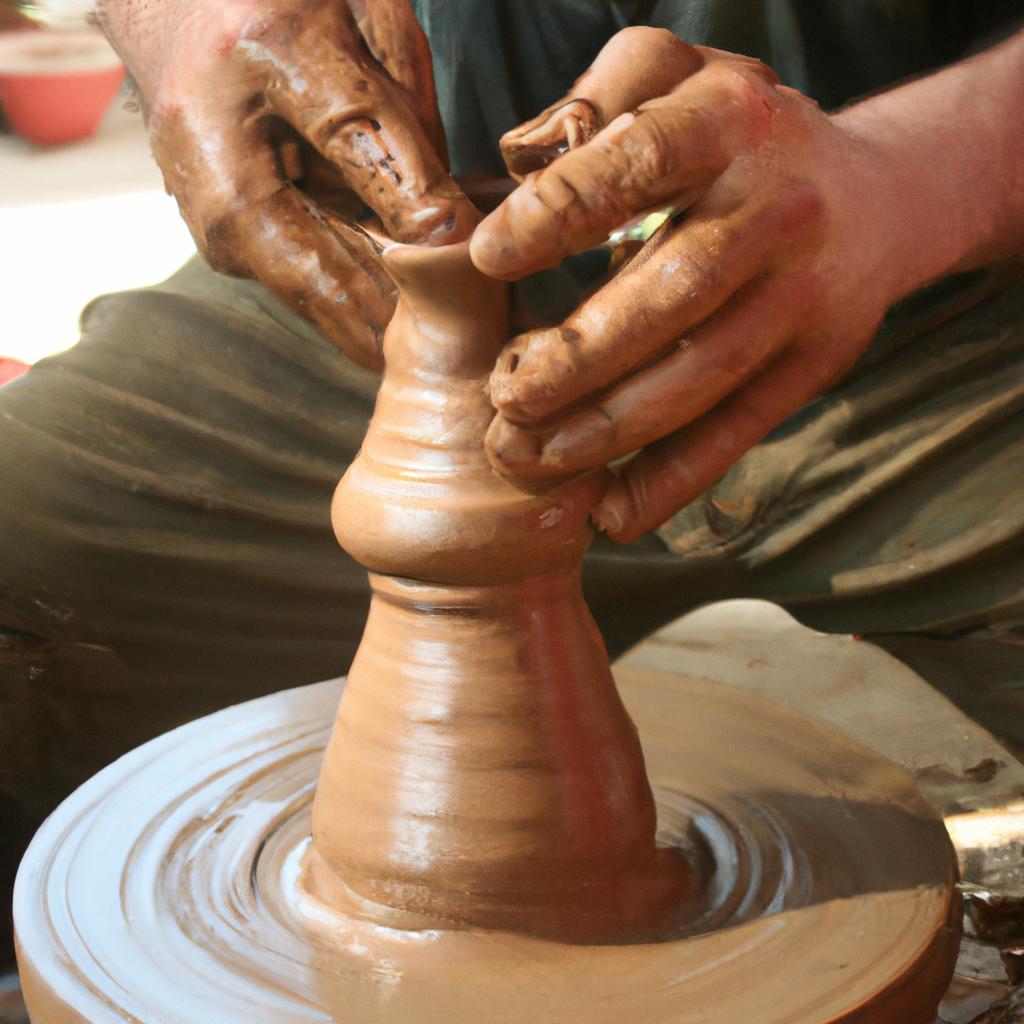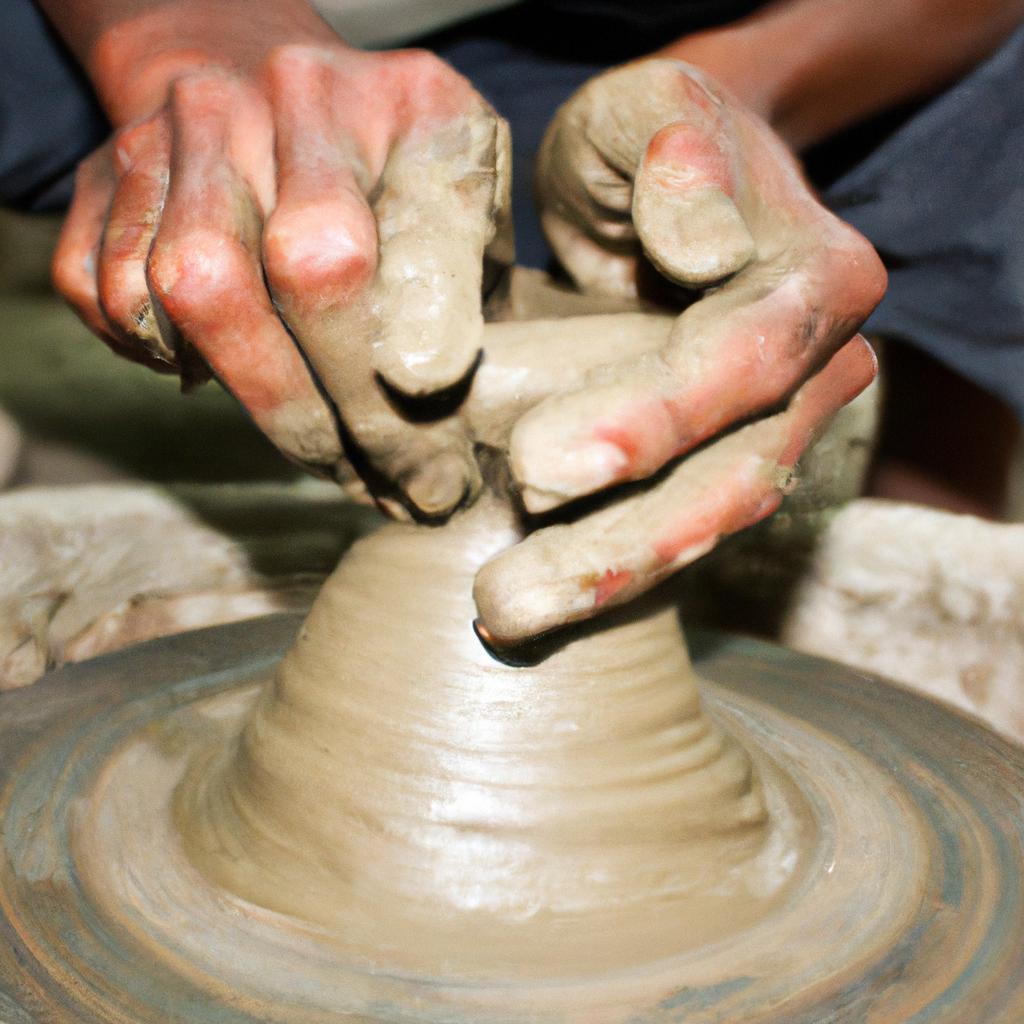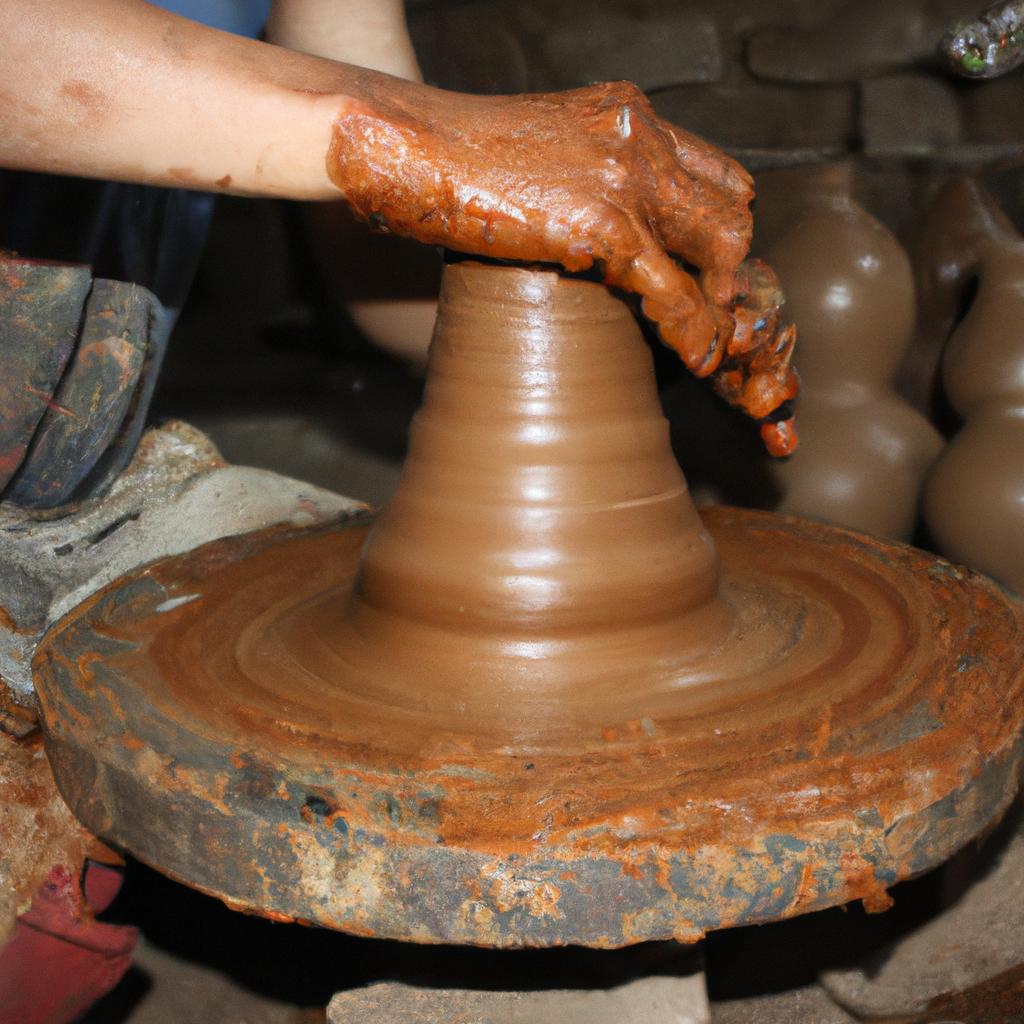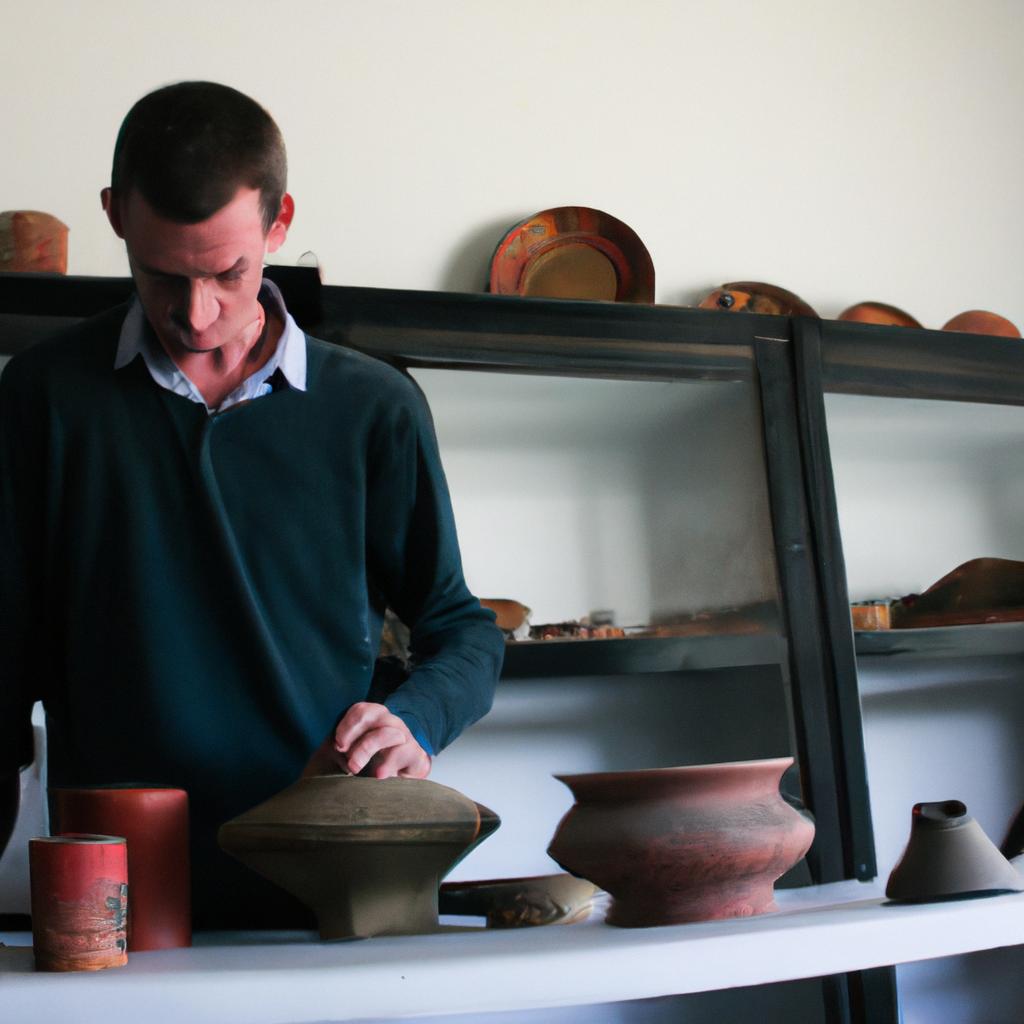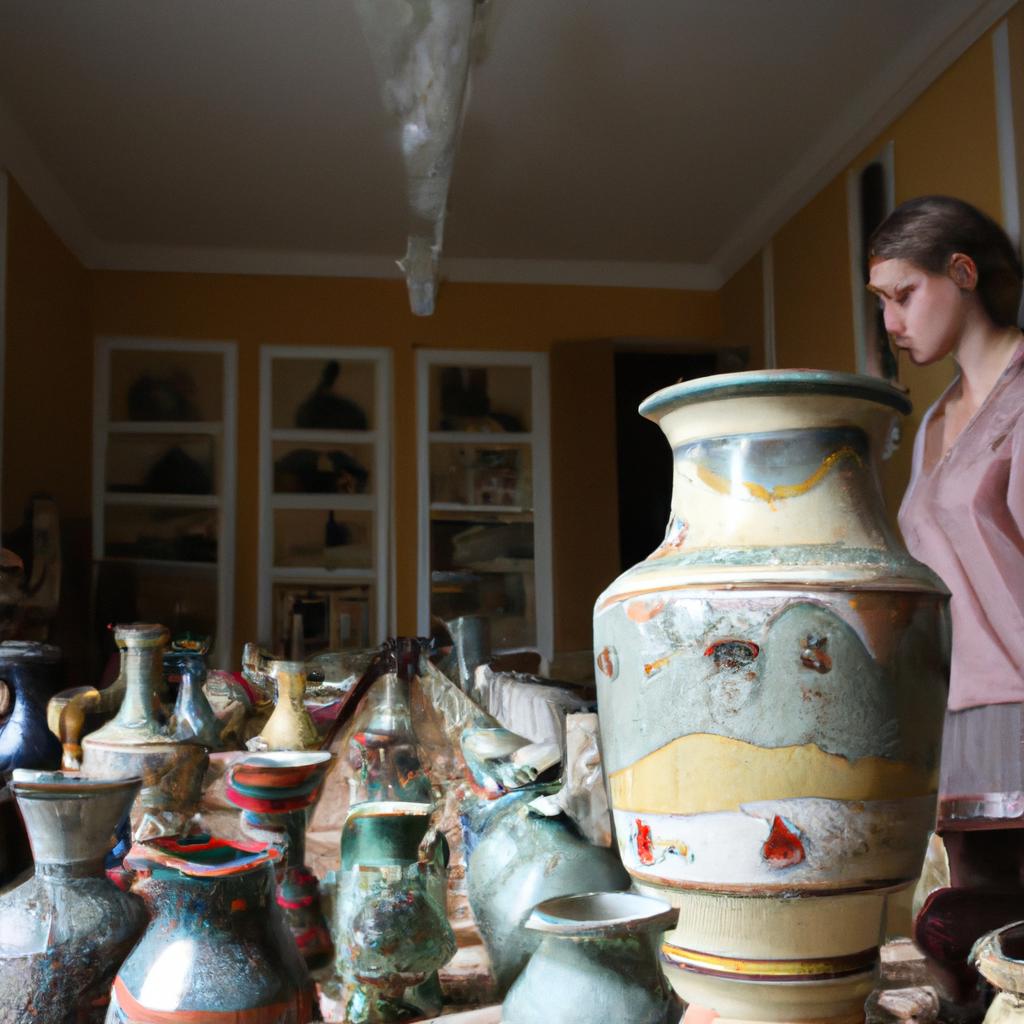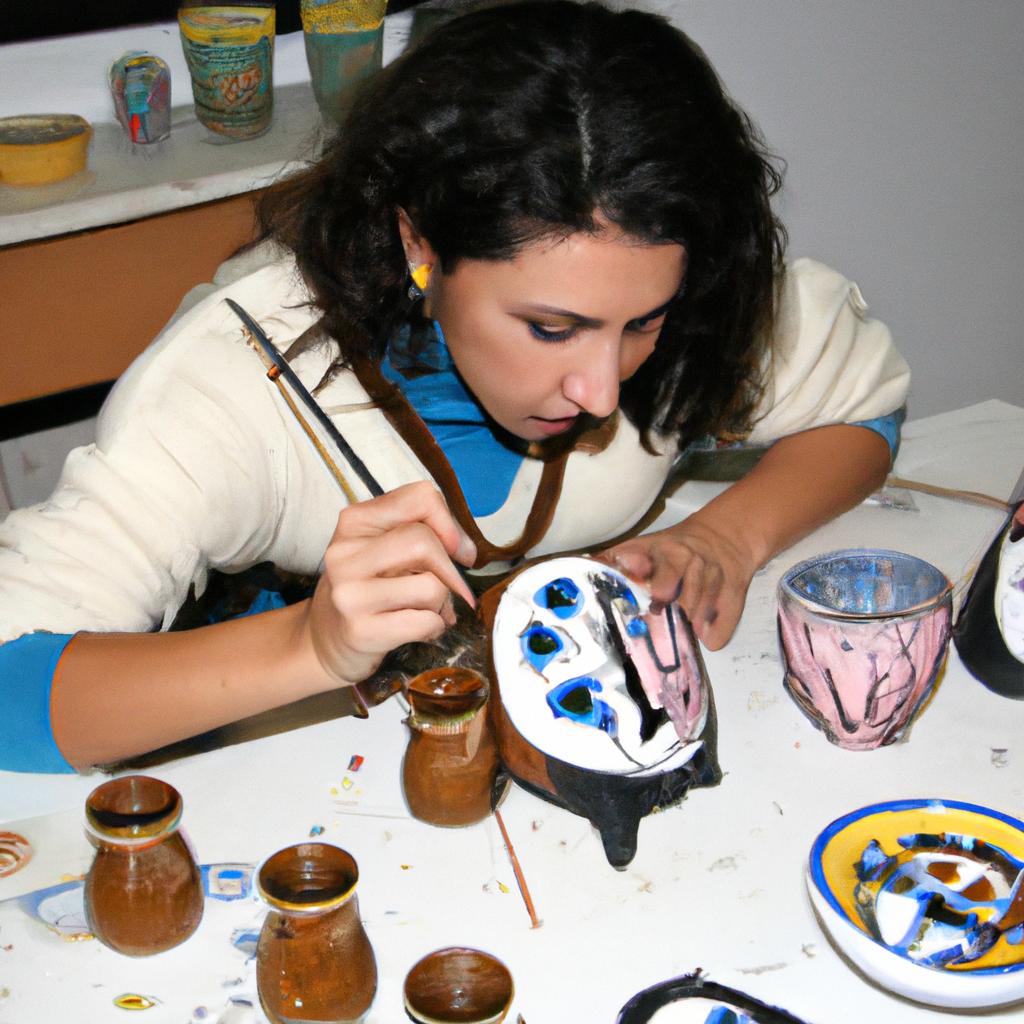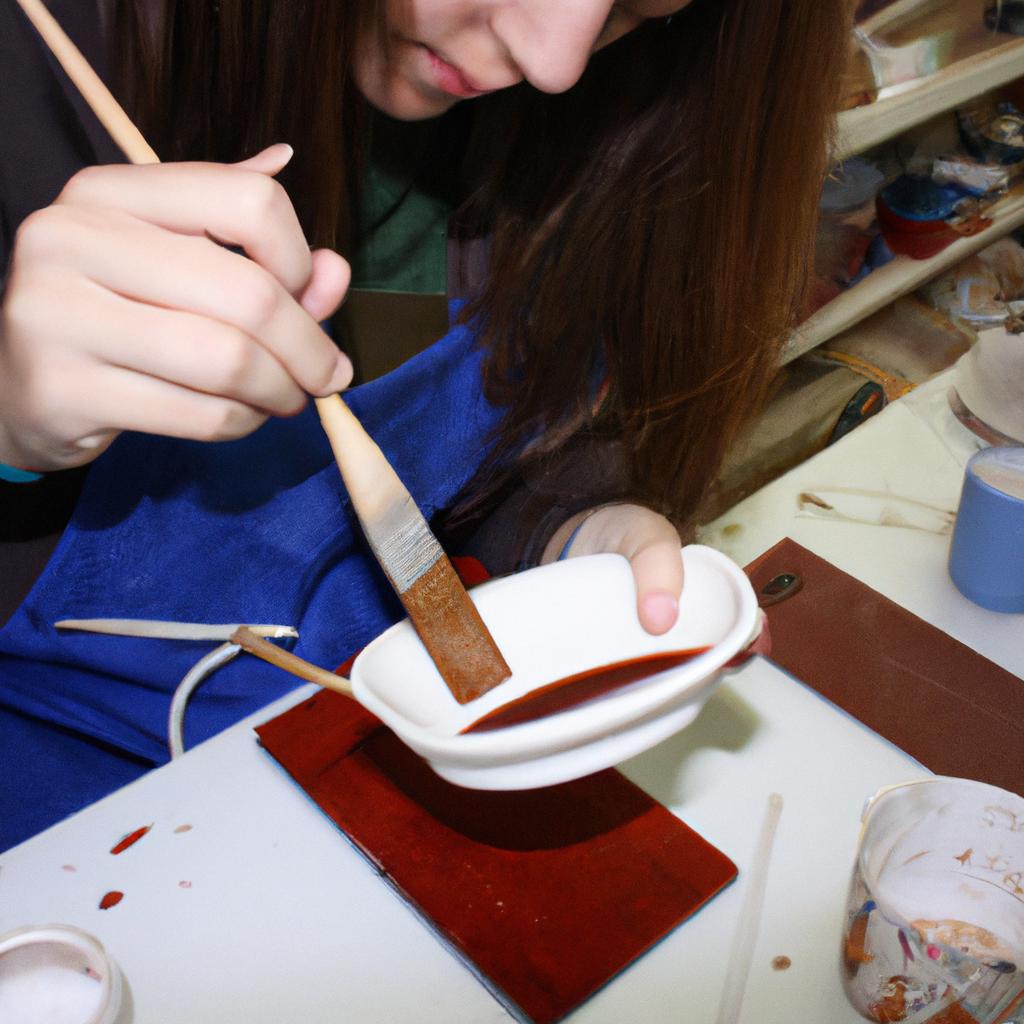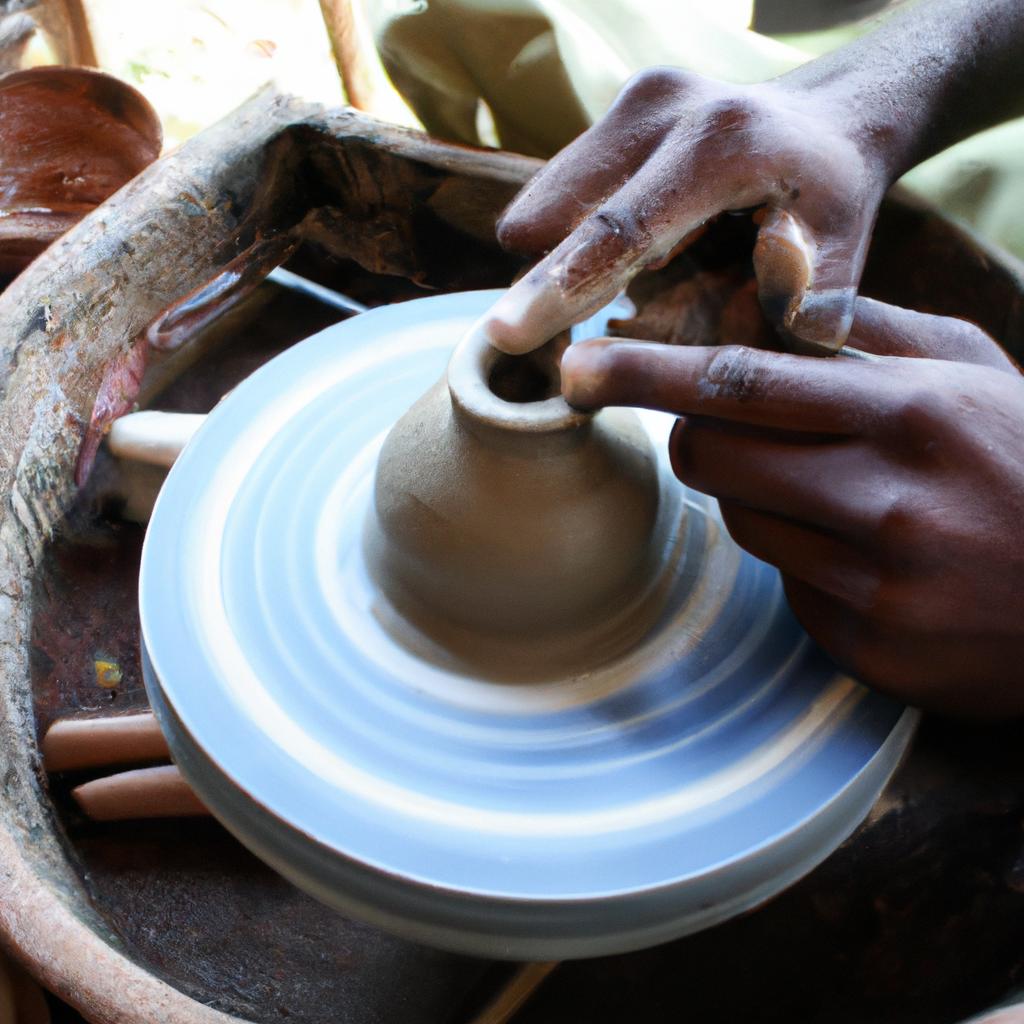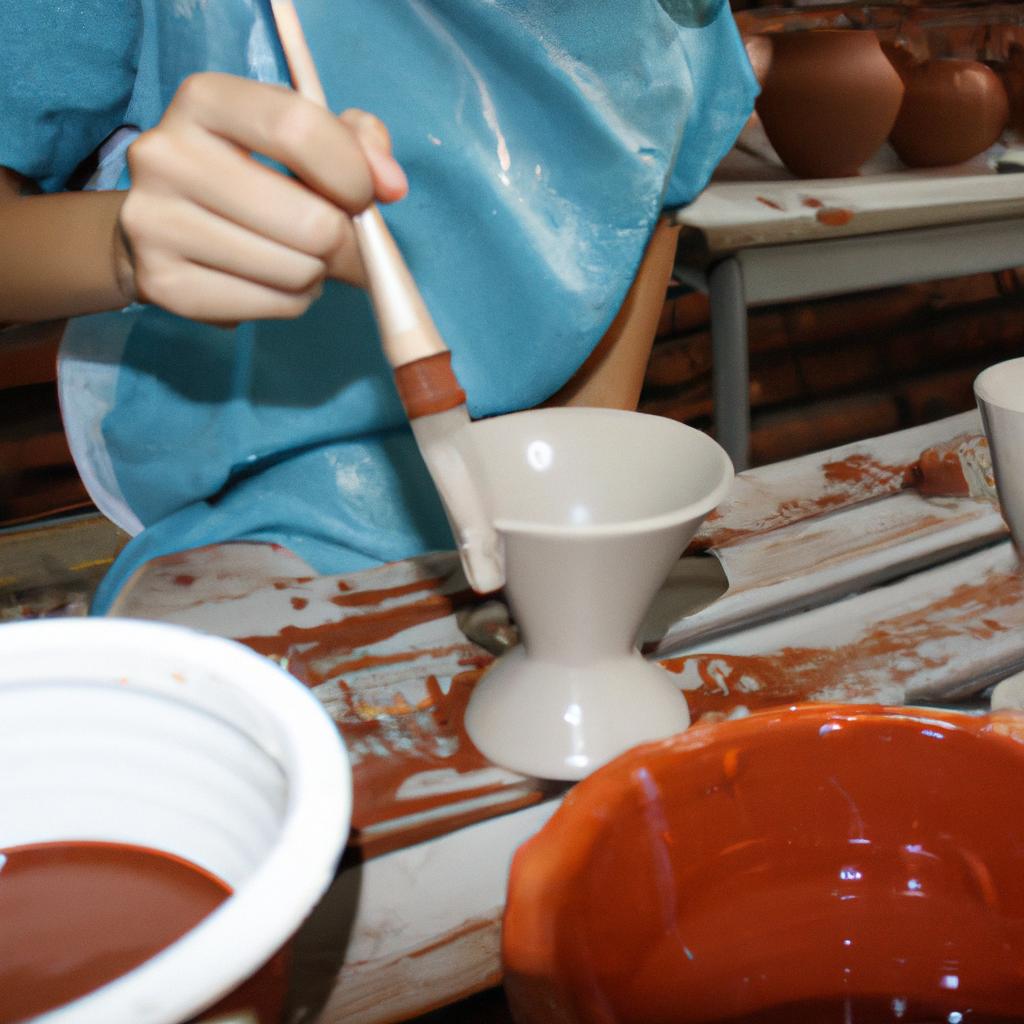The world of pottery has witnessed the emergence and evolution of numerous artistic styles throughout history. Among these, lustre pottery stands out as a captivating form that blends beauty with functionality. Lustre pottery is characterized by its shimmering metallic surface, achieved through the application of metal oxides and firing techniques. This article aims to explore the cultural influences that shaped the origins of lustre pottery, shedding light on how this remarkable art form developed over time.
One intriguing example that highlights the significance of cultural influences in lustre pottery can be observed in medieval Islamic ceramics. The exquisite lusterware produced during this era reflects not only the mastery of craftsmanship but also the rich cultural exchange between various civilizations. Influences from Chinese porcelain, Byzantine and Persian art intertwine in these pieces, resulting in unique designs and patterns that captivate collectors and scholars alike.
Understanding the origins of lustre pottery requires delving into different regions where it emerged prominently. From Spain’s golden age under Moorish rule to Egypt’s Fatimid dynasty, each region contributed distinct artistic approaches to this ceramic style. By examining historical records, archaeological findings, and analyzing stylistic elements found across different lustreware productions, we can unravel the diverse cultural encounters that influenced the birth and development of this mesmerizing art form.
One notable aspect to consider is the influence of Islamic geometric patterns on lustre pottery. Islamic art is characterized by its intricate geometric designs, which are often incorporated into lustreware. These patterns not only add aesthetic appeal but also have symbolic and spiritual significance in Islamic culture. The use of symmetrical designs and repetitive motifs creates a sense of harmony and balance, reflecting the Islamic belief in unity and order.
Furthermore, the trade routes established during the medieval period played a crucial role in spreading the techniques and materials necessary for creating lustre pottery. The Silk Road, for example, facilitated the exchange of ideas and materials between different cultures, allowing artisans to experiment with new techniques and pigments. As a result, lustre pottery became increasingly diverse, incorporating influences from regions as far-reaching as China, Persia, Egypt, and Spain.
In addition to cultural influences, technological advancements also shaped the development of lustre pottery. For instance, the discovery of metallic oxides such as copper and silver enabled potters to achieve the distinctive shimmering effect associated with lustreware. Innovations in kiln technology also allowed for precise control over firing temperatures and atmospheres, resulting in more consistent and vibrant lustre finishes.
Overall, lustre pottery stands as a testament to the interconnectedness of different cultures throughout history. Its origins can be traced back to various regions influenced by trade networks, artistic exchanges, and technological advancements. Today, this captivating art form continues to inspire contemporary ceramic artists who seek to revive and innovate upon this ancient technique.
Historical Background of Lustre Pottery
To fully understand the cultural influences that have shaped lustre pottery, it is essential to explore its historical background. One notable example of this pottery style can be found in the Islamic world during the 9th and 10th centuries. In cities such as Samarra and Kashan, skilled artisans employed innovative techniques to create stunning lustreware ceramics with a luxurious metallic finish.
The production of lustre pottery was closely tied to advancements in ceramic technology during this period. The use of tin oxide and silver or copper compounds allowed potters to achieve lustrous effects by firing their creations at high temperatures while controlling the oxygen levels within the kiln. This resulted in delicate patterns that shimmered in brilliant hues, capturing the imagination of both local patrons and international traders.
When examining the historical context surrounding lustre pottery, several key factors come into play:
- Cultural Exchange: The development of lustreware owed much to the exchange of ideas between various civilizations along trade routes linking East and West.
- Patronage: Wealthy individuals and ruling elites played a significant role in commissioning these exquisite pieces for personal use or as diplomatic gifts.
- Technological Advancements: Innovations in kiln design and glazing techniques marked important milestones in the evolution of lustre pottery.
- Aesthetics and Symbolism: Lustreware often featured intricate motifs inspired by nature, mythology, or religious themes, reflecting the beliefs and values held by different societies.
These aspects demonstrate that lustre pottery was not merely an artistic pursuit but also a reflection of broader socio-cultural dynamics. As we delve further into our exploration, we will uncover how this art form evolved over time, adapting to changing tastes and incorporating new technical approaches – leading us to examine the fascinating topic of “Evolution of Lustre Pottery Techniques.”
In exploring its rich history, it becomes evident that lustre pottery did not exist in isolation but rather emerged as a result of cross-cultural interactions and technological advancements. By analyzing its historical context, we gain valuable insights into the factors that contributed to its development and popularity. Transitioning seamlessly into our next section, we will now delve deeper into the evolution of lustre pottery techniques.
Evolution of Lustre Pottery Techniques
Case Study: In the early 9th century, a small village in Persia became renowned for its exquisite lustre pottery. This unique form of ceramic art captivated both locals and traders from distant lands. The cultural influences behind this craft are multifaceted, connecting various civilizations across time and space.
Lustre pottery reflects the interplay between different cultures, incorporating elements from diverse artistic traditions. To understand its origins fully, it is essential to delve into the historical context in which it emerged. Arab conquests during the Abbasid era facilitated the transmission of knowledge and ideas across vast territories, resulting in significant cross-cultural interactions. These encounters gave rise to new techniques and aesthetic sensibilities that found expression in lustre pottery.
The cultural significance of lustre pottery can be attributed to several factors:
-
Symbolism and spirituality: Lustreware often features intricate designs inspired by nature or religious motifs. These patterns carry symbolic meanings deeply rooted in the beliefs and rituals of ancient civilizations.
-
Trade networks and globalization: Lustre pottery played a vital role in facilitating trade along the Silk Road, serving as valuable commodities exchanged among merchants from different regions. Its popularity transcended borders, leading to widespread adoption and adaptation of this art form.
-
Social status and luxury: Owning lustreware was considered a mark of affluence and sophistication. Its production required skilled artisans who commanded respect within their communities. As such, these ceramics were associated with wealth and high social standing.
-
Preservation of heritage: Over time, lustre pottery became an integral part of cultural identity for many societies. It provided a means through which ancestral traditions could be preserved amidst changing political landscapes.
- Awe-inspiring beauty embedded in every brushstroke.
- Timeless elegance capturing the imagination.
- Resilience against fading into oblivion throughout centuries.
- A testament to human creativity and ingenuity.
| Civilization | Influence on Lustre Pottery |
|---|---|
| Islamic | Development of new techniques such as “underglaze” lustre. |
| Chinese | Incorporation of blue-and-white porcelain motifs into lustreware. |
| Persian | Refinement of the metallic glazing process, enhancing the lustrous effect. |
| Moorish | Introduction of geometric patterns inspired by intricate tile work. |
Transitioning into the next section:
Exploring the Influence of Islamic Art on Lustre Pottery sheds light on how this particular artistic tradition shaped and molded the development of lustre pottery over time. The mastery exhibited in both Islamic art and lustre pottery led to a profound exchange between these two creative realms, each leaving an indelible mark upon the other’s legacy.
Influence of Islamic Art on Lustre Pottery
The Evolution of Lustre Pottery Techniques reveals a significant shift in the production methods and aesthetic qualities of lustre pottery over time. By examining these changes, we can gain insight into how this art form has developed and transformed throughout history.
One notable example that showcases the evolution of lustre pottery techniques is the case of the Hispano-Moresque ceramics produced during the 13th to 15th centuries in Spain. These exquisite pieces were characterized by their vibrant colors, intricate designs, and distinctive metallic luster. Initially influenced by Islamic art, Hispano-Moresque potters experimented with different materials and firing techniques to achieve the desired effects. For instance, they used tin glazes enriched with copper or silver oxide to create luminous surfaces that shimmered under light.
To further explore the cultural influences on lustre pottery, it is essential to consider its connection to broader artistic movements and historical developments. The following bullet point list highlights some key factors that shaped the evolution of lustre pottery techniques:
- Technological advancements: The discovery and experimentation with new materials, such as metal oxides and rare minerals, expanded the possibilities for achieving unique lustre effects.
- Trade routes and cultural exchange: Lustre pottery was not confined to a single region but spread through trade networks across different civilizations. This facilitated the transfer of knowledge and inspiration between diverse cultures.
- Patronage from ruling elites: Wealthy individuals often commissioned luxurious lustreware as a display of power and prestige. Their support provided resources for artists to innovate and refine their craft.
- Religious symbolism: In many cases, religious motifs played a significant role in influencing lustreware designs. Artists incorporated symbols related to various faiths, which added depth and meaning to their creations.
To offer a visual representation of how lustre pottery evolved stylistically over time, consider Table 1 below:
| Time Period | Characteristics | Influences |
|---|---|---|
| 8th – 10th century | Simple designs | Islamic art |
| 13th – 15th century | Vibrant colors, luster | Hispano-Moresque |
| 16th – 17th century | Elaborate motifs | Ottoman Empire |
| 19th – 20th century | Revival of lustre pottery | European Renaissance |
In conclusion, the evolution of lustre pottery techniques demonstrates how this art form has been shaped by a multitude of cultural influences and historical factors. By examining specific examples such as the Hispano-Moresque ceramics, we can see the progression of styles and materials used to achieve exquisite lustre effects. The subsequent section will delve into the Influence of Islamic Art on Lustre Pottery, exploring its impact on both technique and design.
Transitioning smoothly into the next topic, let us now explore the Spread of Lustre Pottery in Europe.
Spread of Lustre Pottery in Europe
Having explored the influence of Islamic art on lustre pottery, we now turn our attention to the spread of this exquisite ceramic technique across Europe. By examining key historical developments and notable examples, we can gain a deeper understanding of how lustre pottery gained prominence outside its original cultural context.
Section – Spread of Lustre Pottery in Europe:
The arrival of lustre pottery in Europe during the Middle Ages marks an important turning point in the history and dissemination of this artistic tradition. One such example is the renowned Hispano-Moresque ware that originated in Al-Andalus (Islamic Spain). This distinct style blended elements from both Islamic and European aesthetics, showcasing intricate designs with vibrant colors and shimmering metallic accents. Its popularity grew rapidly throughout the Iberian Peninsula, inspiring local potters to experiment with their own interpretations.
To illustrate the widespread adoption of lustre pottery across Europe, consider the following factors:
- Trade networks: Increasing trade connections between regions facilitated the exchange of goods, including ceramics. Lustreware items were highly sought after due to their unique beauty and craftsmanship.
- Royal patronage: European nobility played a crucial role in promoting and endorsing lustre pottery as luxury objects within their courts. This royal support further fuelled interest among artists and collectors alike.
- Migration and conquests: Movements such as the Reconquista brought Muslim craftsmen skilled in producing lustreware to new territories, introducing these techniques to diverse audiences.
- Technological advancements: As knowledge about lustre decoration spread, local potters began experimenting with different materials and firing techniques, leading to innovations that contributed to regional variations in lustreware production.
Table: Examples of Lustre Pottery in Europe
| Region | Notable Example |
|---|---|
| Italy | Deruta Majolica |
| Spain | Talavera de la Reina |
| Portugal | Alcobaça |
| England | Liverpool Delftware |
The widespread popularity and influence of lustre pottery across Europe paved the way for its subsequent revival and modern applications. By examining both historical and contemporary manifestations, we can gain a comprehensive understanding of this enduring art form.
Building upon our exploration of the spread of lustre pottery in Europe, we will now delve into its revival and modern applications, uncovering how this ancient technique continues to captivate artists and enthusiasts alike.
Revival and Modern Applications of Lustre Pottery
The Spread of Lustre Pottery in Europe
Building on the rich history and cultural significance of lustre pottery, its influence began to spread throughout Europe during the medieval period. One notable case study is the Moorish invasion of Spain in the 8th century, which brought with it a flourishing tradition of Islamic art and craftsmanship. This influx of artistic inspiration led to a fusion of styles, resulting in the emergence of lustre pottery as an integral part of European ceramic production.
To fully understand the impact and dissemination of lustre pottery across Europe, several key factors must be considered:
-
Trade Routes: The interconnectedness fostered by trade routes played a pivotal role in the diffusion of lustre pottery from its origins in the Middle East. As merchants traversed vast distances, they not only exchanged goods but also shared knowledge and artistic techniques. This facilitated the transmission of lustre-making expertise to various regions within Europe.
-
Patronage: The support and patronage extended by nobles, monarchs, and wealthy individuals greatly contributed to the popularity and spread of lustre pottery. These influential patrons commissioned skilled artisans to create intricate pieces adorned with lustre finishes, thereby elevating this form of ceramics into a symbol of prestige and wealth.
-
Centers of Production: Certain cities emerged as centers for producing exquisite lustreware due to their access to raw materials, skilled craftsmen, and established networks for distribution. For instance, Valencia in Spain became renowned for its vibrant blue-and-gold Hispano-Moresque lusterware that was highly sought after across Europe.
-
Cultural Exchange: The cross-pollination between different cultures through movements such as the Renaissance further propelled the expansion of lustre pottery’s appeal. Artists absorbed influences from diverse sources ranging from classical antiquity to Eastern aesthetics, infusing new ideas into their creations.
Table: Examples of Lustre Pottery Influences Across Europe
| Region | Period | Notable Features |
|---|---|---|
| Spain | 8th-15th c. | Hispano-Moresque lustreware |
| Italy | 14th-16th c. | Maiolica ceramics with lustre decoration |
| England | 17th-18th c. | Transfer-printed pottery imitating lustre |
| Netherlands | 19th-20th c. | Delftware inspired by Islamic motifs |
The widespread dissemination of lustre pottery in Europe during different historical periods demonstrates its enduring appeal and adaptability across various cultures and artistic traditions.
Transitioning seamlessly into the next section, we delve into the revival and modern applications of lustre pottery, exploring how this ancient art form continues to leave an indelible mark on contemporary ceramic practices.

